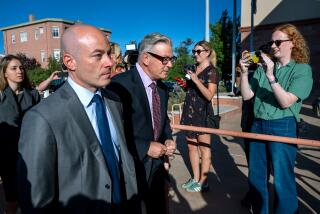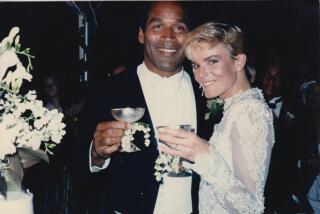Simpson Judge Halts Flesh-Gouging Test
- Share via
The judge presiding over the O.J. Simpson civil trial Tuesday broke up a contentious cross-examination that was on the verge of drawing blood--quite literally--over the crucial issue of how and when Simpson suffered gouge marks on his left hand.
Defense attorney Robert C. Baker challenged expert witness Werner Spitz, a forensic pathologist, to explain how murder victim Ronald Goldman could have torn flesh from his assailant’s hand with fingernails so short the autopsy surgeon could not clip them for analysis. “Would you like me to show you how this works?” Spitz asked.
Baker, who had spent much of the morning shouting and jabbing his finger at Spitz, stalked to the witness stand and responded sarcastically, “Go ahead. Gouge me.” The white-haired pathologist put his hand on Baker’s arm, then hesitated, asking: “You want me to scoop tissue out?”
Baker assented. But before the demonstration could proceed, Superior Court Judge Hiroshi Fujisaki intervened. “Mr. Baker,” he said, “I’m not going to have any gouging of flesh in my courtroom.”
Jurors and spectators burst into laughter, but Spitz still made his point. He took off his jacket, rolled up his sleeve and dug into his own arm with his close-cropped fingernails. He then proudly showed off the resulting indentation and scrape marks. “When you fight for your life and you dig in deep, you push back the flesh [under your own nails] so your fingernail suddenly becomes longer,” he said.
Simpson was not in court for the day’s theatrics. He was in Orange County, trying to regain custody of his children on the first day of a family law hearing expected to last at least two weeks. Simpson smiled and signed autographs as he entered the closed-door hearing, but shrugged off reporters’ questions.
In Santa Monica, meanwhile, the mood was tense and the cross-examination nasty. Baker lost his temper again and again as Spitz gave long, explanatory answers instead of simple yes-or-no responses.
“No, no, no, no, no,” Baker shouted at one point, after Spitz had informed him that his question was misleading. “We’re not here to have you make speeches.”
Amid the fireworks, Baker did manage to get across the chief defense theme: that there was too much blood spattered in too many places to square with Spitz’s reconstruction of the murders, which involved a lone assailant killing Nicole Brown Simpson within 15 seconds, then murdering Goldman in less than a minute and escaping the scene relatively unstained.
Spitz stuck by his conclusion. But he did concede that he had not looked at every photo of the crime scene and had not even counted Goldman’s wounds before estimating the struggle’s duration.
Just as important, Baker got Spitz to acknowledge that fingernail gouges generally do not bleed much, and that blood from such a wound tends to congeal within 10 to 15 seconds. That testimony could cast doubt on the plaintiffs’ theory that Simpson dripped blood at the crime scene, in his Bronco, in his home and possibly even in his Chicago hotel room hours after the murders.
Spitz insisted, however, that some fingernail wounds do bleed more heavily. “I would have to be a wizard to tell you how many drops of blood would come out of that [gouge], and I am not a wizard,” he said.
Under friendlier questioning from plaintiff attorney Edward Medvene, Spitz offered new explanations for some of the victims’ wounds.
He identified a bruise on the left side of Nicole Simpson’s mouth as probably the result of “a punch from a fist.” The impact of the punch, he testified, would have sent her reeling, causing her to strike her head and scrape her elbow on a nearby stucco wall. “Dazed from the blow,” she would have been unable to resist as the killer yanked back her head and slit her throat, Spitz said.
In the criminal trial, prosecutors had suggested that the killer deliberately knocked Nicole Simpson unconscious by smacking her with the blunt end of the knife or by hitting her on the head. The bruise around her mouth did not figure into their scenario.
Spitz also discounted one of the prosecution’s most horrifying theories: that the killer twice drew a sharpened blade across Goldman’s throat as a means of taunting or torturing him before the fatal blows.
On the contrary, Spitz said he believes that the murderer simply had second thoughts about going through with the gory act since Goldman was already nearly dead, his heartbeat weakening by the second because of extensive internal bleeding. “The throat slashing did not materialize,” Spitz said, “because there was no resistance [from Goldman], and all the assailant had to do was let him drop.”
More to Read
Sign up for Essential California
The most important California stories and recommendations in your inbox every morning.
You may occasionally receive promotional content from the Los Angeles Times.













